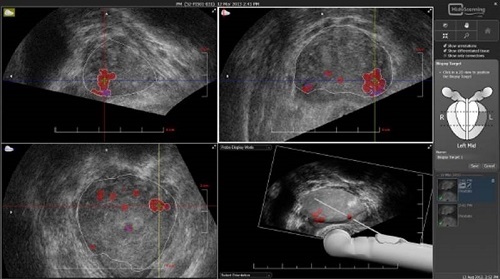Diffuse prostatic changes can occur in men at different ages. To reveal a pathology it is possible only at ultrasonic diagnostics. Diffusive changes in the gland occur against the background of various pathological processes taking place in it. With any alarm, the patient must immediately visit the urologist.

What is this disease?
The prostate gland is a male organ. In female organisms, there is none.
Prostate produces hormones in the male body. Testosterone helps to develop in boys a secondary sexual sign. Against the backdrop of the prostate, the man's voice becomes rough, the hair of certain areas of the body appears, the shoulders grow and the pelvis tapers.
For various reasons, the inflammatory process occurs in the prostate gland. Inflammation can occur due to factors such as:
- Urinary system infection;
- Injury of the inguinal zone;
- Hormonal failures;
- Chronic diseases of the prostate.
The pathological process affects the structure and structure of the prostate. Due to the violation of the metabolism of prostate tissues, the walls of the gland change their structure. A healthy tissue is replaced by cells that are not characteristic of the gland. Changes in the cavity of the prostate gland can occur. Cells of connective tissue begin to grow actively and form spikes. Adhesive process can be active and slow. Under the influence of various diseases, iron can begin to increase in size. The walls become denser, the shape changes. All these processes are referred to as diffuse changes in the prostate.
Forms of pathological process
Diffuse changes can manifest themselves in different ways. Doctors distinguish four main types of pathology:
-
 Hypoplasia of the walls;
Hypoplasia of the walls; - Dysplasia of the walls or tissues of the prostate;
- Hyperplasia of the walls;
- Atrophy of organ tissues.
Hypoplasia occurs in men aged 16-18 years. Pathology is associated with underdevelopment of the prostate gland. Its walls are thin, the dimensions are small. Men who have an underdeveloped gland develop according to the eunuchoid type. Pathology can be identified by passing a detailed analysis of hormones and ultrasound diagnosis.
Hyperplasia of the prostate gland arises from chronic inflammation. Epithelial cells of the prostate grow and form nodules. Nodules squeeze the urinary tract. In medicine, hyperplasia is called prostatic adenoma. Hyperplasia is a benign disease. Nodules do not give metastasis to other parts of the patient. This is the main difference between adenoma and prostate cancer.
Atrophic processes in the tissues of the body can occur due to hormonal disorders. Hormones affect the structure of the reproductive system of the patient. If a man has pathologies of development of external genital organs, then the gland begins to die. Atrophy can develop due to testicular orchitis. If you do not call the surgeon on time, the body will have to be removed.
Dysplasia occurs much more often than other diffuse changes. With dysplasia of the gland, tissue areas appear on its walls that are uncharacteristic of the prostate. Dysplasia is divided into three forms:
- An easy degree of dysplasia;
- Pathology of moderate severity;
- Third degree of dysplasia.
The first and second stages are characterized by small areas of atypical cells. The third form of dysplasia can quickly degenerate into an oncological form. The disease requires immediate medical attention.
How to identify the disease
 Establish changes in the prostate gland can be done by ultrasound. A healthy organ should be of the correct form. The contours of the organ are clear, without visible pathologies. At visual inspection on the screen of iron has five zones, seminal vesicles are well looked through. The transverse size of a healthy prostate should not exceed 35 cm.
Establish changes in the prostate gland can be done by ultrasound. A healthy organ should be of the correct form. The contours of the organ are clear, without visible pathologies. At visual inspection on the screen of iron has five zones, seminal vesicles are well looked through. The transverse size of a healthy prostate should not exceed 35 cm.
If the organ has any pathogenic changes, then the doctor puts a diffuse change in the prostate. The altered prostate can have the following pathologies on the examination:
- Reduced echogenicity of individual parts of the prostate;
- Anaecogenous zones;
- Hyperechogenicity of the prostate cavity.
Reduced echogenicity of individual parts of the gland indicates a slow chronic prostatitis. Inflamed tissues are densified and poorly visible on the screen. Anechogenous translucence indicates an abscess in the prostate. This condition requires immediate surgery. If pathology is ignored, sepsis of blood may occur.
Hyperechogenicity of the gland is usually manifested in combination with increased body temperature. Symptom indicates the presence of acute prostatitis. The patient is treated under hospital conditions.
Therapy used
Methods for treating diffuse changes in the organ depend on the detected disease. Chronic prostatitis can be treated with combination therapy. For treatment use a combination of medications and physiotherapy. Acute prostatitis can be treated with two methods: medically and surgically. Surgical intervention is performed in the presence of calcification in the prostate cavity. The stones are extracted from the gland through the incision region of the urethra. This technology is called transurethral resection.
Various tumors are removed from the organ through an incision on the lower part of the peritoneum. If the tumor has an oncological etiology, the patient needs further treatment.
In addition to drugs and surgeries, patients need to monitor their lifestyle. A man should lead an active lifestyle, have the right eating habits, and undergo an annual medical examination.
Conservative treatment includes massage of the prostate gland. The procedure improves the nutrition of tissues, increases blood flow. Massage strengthens the walls of the prostate and strengthens its resistance to disease.
If a patient has been exposed to diffuse changes in an ultrasound study, then he needs to undergo further examination. The doctor will help to identify the cause of the pathology.



